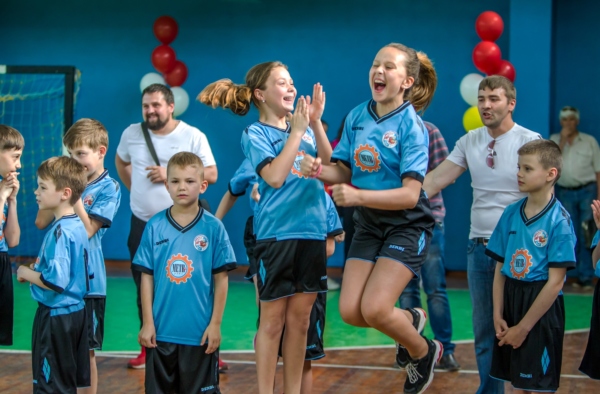This summer, five players from the St Andrews University Volleyball Club spent up to two months in Zambia. In cooperation with the Zambian NGO Sport in Action (SIA), who help facilitate volleyball at the grass root level.
 With our project Saints Volleyball Outreach (SVO) we set out for Zambia to trigger interest in volleyball, develop local coaches and exchange ideas. Our focus was on utilising volleyball to improve self-esteem, life skills and benefit entire communities.
With our project Saints Volleyball Outreach (SVO) we set out for Zambia to trigger interest in volleyball, develop local coaches and exchange ideas. Our focus was on utilising volleyball to improve self-esteem, life skills and benefit entire communities.
On the ground, we worked at three placements of SIA: Chipata, Munali, and Fountain of Hope. At each school we received great support from the responsible SIA peer leaders.
Our project took on two volleyball components: day-to-day coaching in schools, and separate clinics to train players and coaches from Lusaka. Beside volleyball-specific sessions, every-day activity at the schools often comprised P.E. sessions and forums on topics such as HIV/AIDS, gender or simply intercultural exchange.
Developing Coaches and Players
During our first weekend in Lusaka we hosted over twenty students, peer leaders, coaches and teachers at the SIA headquarters for a coaching clinic. The session focused on topics such as empowerment, goal-setting, and practice organization. At the end of the day we were able to go into greater technical detail on positioning and movement on the court. The clinic also served as a forum for the exchange of ideas. In interactive group work we discussed our understanding of good coaching and the skills most essential to be a good coach.
Throughout this clinic we received a great deal of advice and assistance from Tila, a SIA employee who also worked at the OYDC and was an accomplished international volleyballer in her third year as Captain of the Zambian National Volleyball Team.
The following week we held an inter-site clinic at the Olympic Youth Development Centre in Lusaka. The OYDC is a multi-sport complex built only a few years ago, in partnership with the International Olympic Committee. We chose the most promising and enthusiastic players form each placement to give them the chance to meet their likes, build ties and learn from each other.
Youth Development Centre in Lusaka. The OYDC is a multi-sport complex built only a few years ago, in partnership with the International Olympic Committee. We chose the most promising and enthusiastic players form each placement to give them the chance to meet their likes, build ties and learn from each other.
Tila also included some of the players that she trains at the OYDC on a regular basis. This was an excellent chance to train with experienced players to work on more advanced techniques, something that is often difficult to do in classes of large numbers, or with sub-par equipment. The event was met with great enthusiasm from the players’ side.
The highlight of our activities in Lusaka was our inter-site tournament in the mid of July. With the help of Tila in organizing transport, food and venue the tournament took place at OYDC with the three SIA teams Munali/Tionge, Chipata, Fountain and the Edusport team Kalingalinga.
After a contested competition that Chipata won, all the participants received certificates and t-shirts from our donations. The MVPs Organ from Chipata and Gloria from Fountain could be happy about a pair of kneepads and the winning team was equipped with a set of Jerseys donated by the SVA.
None of the 50 players owned a pair of kneepads, sports shoes (trainers) are very rare and most players contently play barefoot. Due to lack of shorts, girls often play in skirts and boys in jeans or other trousers. Apart from the individual players the schools are equally poorly equipped. Volleyball practice used to be run with one to maximum two volleyballs, if they were lucky on courts of tar but usually on the sandy red soil that made up most of the Zambian ground. It was uneven, covered with sharp stones, glass and sometimes even razor plates.
 Stocking up the equipment was probably one of the most necessary and helpful things we could do to support volleyball at the grass root level. With at least twelve players attending a practice, having six balls instead of one opens you a lot more possibilities in terms of devising a training, challenging the players and developing individual potential. It is likewise essential to keep up the motivation and attention of the players. Thanks to the SVA, Sportset.com, and others we had collected and brought over more than thirty balls, five of which we left at each placement with one ball bag, while the rest remained with SIA.
Stocking up the equipment was probably one of the most necessary and helpful things we could do to support volleyball at the grass root level. With at least twelve players attending a practice, having six balls instead of one opens you a lot more possibilities in terms of devising a training, challenging the players and developing individual potential. It is likewise essential to keep up the motivation and attention of the players. Thanks to the SVA, Sportset.com, and others we had collected and brought over more than thirty balls, five of which we left at each placement with one ball bag, while the rest remained with SIA.
The work of SIA
During our time in Lusaka, one of the most significant benefits of volleyball became apparent: its value as a communication tool . Many of our practices focused on themes of respect, teamwork, and a positive attitude. Since volleyball is such a fun activity, it’s easy to forget that sports keeps students engaged in a healthy activity and out of trouble. The enormous power that good coaches wield, and sport’s potential to do good in a community.
The future of our project
Our project aims to do more than just send coaches from the UK to coach volleyball for a few weeks. SVO endeavours to create a lasting legacy. Looking forward, one of our chief aims will be to work with Sport in Action to develop the coaching and equipment facilities. While not around we want to sponsor the organization of tournaments to provide the children with playing opportunities and competition.
It is likewise important to us to share these benefits within the community of St Andrews. From this semester on, we will contribute to a weekly volleyball outreach session at Madras College and further schools along with our coaches from the University Club.
We are also looking to partner with other UK universities to join forces with other enthusiastic volleyball players and maximise our impact.
For more detailed description of our day-to-day experience and contact check the website
Maureen MacIsaac & Hannah Berwian
St.Andrews University Volleyball Club


